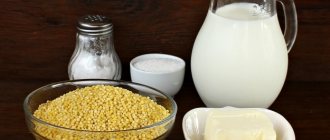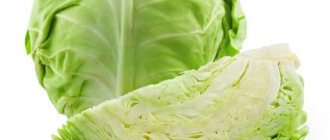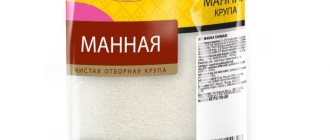When can milk porridge be introduced into complementary feeding and nutrition for a child?
Very often I hear from mothers about how beneficial milk is for their children. As for maternal or cow, most people don’t see the difference, unfortunately. Meanwhile, it is huge. It’s not for nothing that nature has come up with its own composition for each species of animal and for humans. If a one-week-old kitten is torn from its mother and fed cow's or goat's milk, it may die. For children, of course, everything is not so critical. But, when you start introducing complementary foods, still distinguish your milk from cow's milk. Especially when you get to the porridge. Because for almost 90% of mothers, the concepts of “porridge” and “dairy” for young children are inseparable. Today we’ll talk about when a child can have milk porridge in their diet and complementary feeding.
How to choose good potatoes?
The best potatoes for a child are those grown in your own garden without adding chemical fertilizers. Unfortunately, not everyone has the opportunity to grow vegetables at home. In this case, you have to be extremely careful when buying vegetables in a store or market. When buying potatoes, you should pay attention to:
- Tuber size. It is best to buy a medium-sized vegetable.
- Wateriness. When there is a lot of water in the tubers, this indicates a large amount of nitrates in the fruit. To check, you can cut the tuber or pierce it with a toothpick. If water leaks through the hole, it means the vegetable is full of nitrates.
- Manufacturer. It is desirable that the potatoes be locally produced, and not brought “from abroad”.
- Stock up on potatoes during the harvest season, so you will be protected from buying genetically modified vegetables.
When was the time?
From the moment you start introducing your baby's first complementary foods, milk porridges should not be at the top of the list of foods for complementary feeding. It doesn’t matter at all whether you cook them with cow’s or goat’s milk. Because animal milk contains quite complex proteins that are difficult for a small body to digest and absorb. Moreover, in large quantities. Such a load is fraught, firstly, with problems with stool, and secondly, with the “acquisition” of allergies.
I have already drawn your attention to the fact that it often occurs when the intestines cannot cope. The immune cells located in it mistake the “indigestible” product for an “enemy”. Read more about allergies to cow's milk protein in infants>>>
There is no need to start complementary feeding with milk porridge. Even if you introduce complementary foods very late. The immature digestive system begins to increase the necessary variety and quantity of bacteria and enzymes to digest complex food gradually, precisely as it becomes “complicated.” Only then will possible problems be minimized.
How to properly introduce complementary foods and what foods to start with and in what quantities, see the online course ABC of complementary feeding: safe introduction of complementary feeding to infants>>>
But porridge is healthy!
Of course, any product from our table is useful, especially natural ones, such as cereals. But this does not mean that from birth a baby needs to be fed everything that we consider healthy. The real benefit of each product occurs when the body is ready to handle it.
Then the milk porridge will enrich the little body with essential vitamins and microelements, nourish it with energy, help it grow and develop. Each cereal, besides this, is somewhat different:
- Buckwheat is especially rich in iron, which is useful for preventing anemia;
- Corn improves peristalsis, promotes timely emptying of the intestines, strengthens the heart and blood vessels, and improves immunity;
- Rice provides energy, has enveloping properties, reduces intestinal irritation, which is important for diarrhea, etc.
However, please note: porridge can also cause harm: semolina can cause allergies and “gain” weight on the little one, rice can cause constipation, and cereals such as barley, oatmeal, and wheat are dangerous due to the risk of allergies and digestive disorders.
When does that very time come when “it’s time” to introduce milk porridge into a child’s complementary feeding? Let's understand: we start complementary feeding at six months (preferably with vegetables), it is better to start introducing cereals later - 1 - 2 months after that. Read more in the article: Porridge for first feeding>>>
First porridge, milk - then
Like this? Is it possible to cook milk porridge without milk? I’ll answer with a counter question: do you think milk or dairy-free cereals are introduced first into complementary foods, and why?
Well done if you answered – dairy-free. They are introduced around 7 months (or a little earlier). The fact is that it is easier for the small gastrointestinal tract to digest cereal fiber and carbohydrates than heavy animal milk protein. Moreover, milk protein along with cereals.
Now let’s look at the sequence of introducing cereals into the baby’s diet. I will say right away that this sequence is suitable for weakened children and very anxious mothers. If you follow the pedagogical complementary feeding scheme, then there is no need to maintain such a clear sequence in the introduction of cereals and products:
- Start with buckwheat - it is the easiest to digest and hypoallergenic;
- After 1 - 2 weeks, offer your little one rice porridge (not white rice!);
- After another 1 - 2 weeks, if tolerated well - corn.
These cereals were not chosen as the first cereals for complementary feeding and nutrition of children. They do not contain gluten, a special complex protein (representing gluten). I have already said that foods that are difficult to digest are regarded as allergens at an early age. Therefore, introduce gluten (still not dairy!) cereals later than gluten-free ones.
Here, too, there is a sequence in terms of digestibility: oatmeal, then barley, wheat, rye. Set aside the semolina for another month. It is the most problematic for baby food, since it is made from wheat, but undergoes special processing, during which it partially loses its beneficial properties. Read more about semolina porridge in complementary foods>>>
What about milk? When can a child have milk porridge? Milk protein is introduced into the baby's diet for about a year, due to the risk of the same allergy. For the first complementary feeding with milk porridge (that is, “cereal complementary feeding, and not the first in general!), follow the same sequence of products. And start it only when the baby is already accustomed to porridge in the water (this could be 10.5 - 11 months, but not earlier).
Milk porridge for a 1-year-old child can already be gluten-free and 100% milk-free. Please note that if your child is prone to allergies, do not rush into gluten and milk. Leave them for 14 – 18 months. Until that time, let the baby’s diet consist of hypoallergenic vegetables, meat products, cereals and fruits.
What cereals are good for young children?
Just a few years ago, parents did not have a question about how many months to introduce semolina porridge into their baby’s diet. The product was given to infants if there were indications of insufficient weight gain or the need to diversify the diet. Over time, the opinion began to gain popularity that it is not recommended to use semolina for these purposes, it has too many negative properties.
Some information sources note that it is best to start giving semolina porridge not to a baby, but to a baby who has completely abandoned mother's milk. Experts who oppose this approach justify their opinion with the following facts:
- Semolina contains a lot of vegetable protein. This building material, which promotes development and growth, must be given to small children, otherwise metabolic processes may slow down.
- The product consists of 70% starch, which can provide the child’s body with the necessary energy.
- Semolina is rich in vitamins E, PP and group B, mineral components necessary for normal tissue development and optimization of chemical processes.
- Regardless of how many degrees of processing the cereal is subjected to, it practically does not lose the listed beneficial properties.
- We must not forget the high degree of nutritional value of the product, which becomes simply necessary when the baby can no longer get enough of the mother’s milk.
No one denies that semolina porridge is accompanied by negative aspects, but they only appear if the product is given to a too small child or if it is acted contrary to the rules and dosages:
- Semolina contains phytin, a component that improves liver function and has antioxidant properties. When a substance enters a child’s body in too large a volume, it interferes with the absorption of calcium and promotes its removal from tissues.
- The cereal also contains gluten. It in itself is not a very useful component, and if you give it to an infant, you may encounter intolerance to the product or an allergy to it.
Tip: As your child gets older, the risk of developing gluten intolerance decreases significantly. If you suspect this condition, you should stop trying to introduce semolina porridge into your baby’s diet until he is at least 10-12 months old.
- Glyodine can disrupt the absorption of nutrients by the intestinal villi, causing their necrosis. But this only happens with uncontrolled and regular use of the product.
- In large volumes, semolina reduces the quality of absorption of vitamin D and iron by the body.
We suggest you read: Is it possible to work out in the gym during pregnancy: what exercises are allowed?
On the one hand, the inconsistency of the product is obvious, on the other, its benefits are too high to refuse. It turns out that you need to decide from how many months experiments with nutrition will be justified and safest.
The question of whether it is acceptable to raise children on semolina, as was done in Soviet times, arose before doctors only 10 years ago. This is due to progress in methods for diagnosing allergic diseases, as well as metabolic disorders.
Semolina itself is not dangerous for children, because it is not for nothing that several generations of children have grown up on it. But in some conditions that cannot be diagnosed in time, taking it can worsen the baby’s condition. Therefore, now, as a preventive measure, the introduction of semolina porridge into the child’s complementary foods has been postponed. We will talk about the reasons, as well as how to properly prepare and feed your baby semolina below.
Semolina itself is small grains and dust formed during the threshing of wheat. They are collected separately and packaged according to particle size and labeling. Therefore, the composition of semolina is identical to wheat. It is rich in microelements (phosphorus, potassium, iron), vitamins E and group B. With a small amount of protein, it contains only 1% fat.
Semolina porridge is used as a nutritious product for diseases of the kidneys, digestive system, and also after operations.
Along with positive properties, semolina also has negative ones. Large amounts of phytin and the microelement phosphorus affect calcium metabolism, causing it to be washed out of the bones. Also, semolina, like wheat, can cause allergies. Everything here is individual.
Some mothers rush to the other extreme, completely excluding semolina porridge from the children's diet. It is important to understand that moderation in diet does not hurt. It is better to offer it to children after a year. You shouldn’t overuse this nutritious and high-calorie dish; it should be on your baby’s menu 1-2 times a week.
Most pediatricians are inclined to believe that semolina is not recommended for children with intestinal problems, indigestion, excess body weight, and allergic diseases. The rest, with normal development and no contraindications, can be introduced into complementary foods, but not more often than the above-mentioned amount.
At the same time, some health workers do not consider the dish necessary and do not see anything wrong if the baby never tries it.
So, if the child is healthy and he likes semolina porridge, then let him eat as healthy as possible, but in moderation. Moreover, its cost is low, its nutritional and taste properties are high. If not, then there is no need to force it. It can be perfectly replaced with other cereals.
- 5.5 – 7.5 months: rice, corn or buckwheat cereals.
- 7.5 – 8.5 months: you can slowly start giving oatmeal and mixing several types of cereals at one meal.
- 8.5 – 10 months: start introducing wheat or millet cereals, and you can also dilute the porridge with fruit or vegetable puree.
- 10 – 12 months: in the case of normal development of the child’s body, at this age you can give semolina for the first time.
- 12 months or more: if you are convinced that your child does not have any allergies, then start cooking cereals not in water, but in low-fat cow's milk.
After you have found out which porridge you can start with and which grain complementary foods you can finish with, it is worth finding out which cereal is most useful for strengthening a growing body.
About 30 years ago, semolina with milk was an indispensable dish served in all kindergartens. After some time, doctors found out that semolina porridge gained its popularity undeservedly, because it does not contain any vitamins or essential nutrients. Frequent consumption of semolina in childhood is not only not useful, but even harmful.
Abuse of this dairy dish leads to disruption of the child’s intestinal microflora and also prevents the body from absorbing vitamins D and calcium, as it has a detrimental effect on absorption by the intestinal walls. Semolina with milk should be given to a child no more than 1-2 times a month for variety.
Wheat porridge, like millet porridge, is not recommended at all for very young children. It is healthy, contains a lot of fiber, but is difficult to digest. Many pediatricians believe that it should be given only after reaching 1.5 years.
Buckwheat is the invincible “champion” in terms of the amount of iron among all other cereals. And in addition to iron, it contains magnesium, potassium and many other minerals. It is perfectly digestible and serves as a “building material” for the child’s body, and especially the digestive system.
In the hierarchy of healthy cereals for children's bodies, oatmeal with milk is in second place after buckwheat. Oatmeal can be prepared from flakes by first grinding them in a blender or coffee grinder, or you can also buy ready-made bags of porridge for infants.
It is impossible to say exactly at what age you should start giving cereal to your child. In this matter, you need to listen to the advice of your pediatrician. But this is not enough: you also need to listen to the child. He himself will let you know what type of cereal he likes, whether he likes milk porridge or whether he prefers cereal dishes with water.
Semolina is particles of ground wheat. On store shelves you can find cereals of different sizes. But its composition will be the same and similar to the composition of wheat. It contains a lot of microelements (phosphorus, potassium, iron) and vitamins, including vitamin E and B vitamins. Semolina contains only 1% fat and 70% starch, which is so necessary to maintain energy in the body. During the grinding process, fiber disappears almost completely, so the product is easily and quickly absorbed by the child’s body.
If you choose a recipe and prepare the dish correctly, then this porridge will be of great benefit to children over 10 months old.
- Folic acid normalizes the nervous system.
- Silicon improves the condition of teeth, making them strong and durable.
- Vitamin E promotes physical and mental development.
- Semolina porridge, entering the body, envelops the mucous membrane. This relieves spasms and inflammation.
- Potassium and magnesium improve heart function.
We suggest you read: Is it possible to drink rosehip tea during pregnancy?
Semolina cooks quickly. When preparing it, all nutrients are preserved. But you need to know from what time to introduce the product into the child’s diet, since there are also disadvantages:
- Semolina contains a lot of phytin and phosphorus, which wash calcium from the bones.
- Excessive consumption of semolina leads to constipation in a child.
- This porridge interferes with the intake of vitamins, especially vitamin D, into the body. Therefore, it is impossible to feed semolina porridge often.
- Contains protein - gluten. Cereals that contain such protein are not recommended for children under one year of age. Gluten intolerance (celiac disease) and allergies to it are common.
- The protein gliadin can interfere with the absorption of nutrients by the intestine.
And now - let's prepare
It's time to talk about how to cook milk porridge for a child.
- Wash the cereal thoroughly and then dry it by spreading it in a thin layer on a kitchen towel.
- Usually take 2 teaspoons of cereal per glass of milk.
- Oatmeal and semolina are poured into boiling water, the remaining cereals are poured into cold water and put on fire.
- The liquid should evaporate gradually, so cook over low heat.
- To prevent the porridge from burning, it must be stirred constantly.
- Just cool the finished porridge at first. Gradually, you can begin to improve the dish with a small amount of salt, sugar, butter, fruit puree.
Let me remind you that if the baby has a tendency to allergies, gluten grains and milk are introduced into his diet later.
If you want to make do with ready-made milk porridges for baby food, choose those that are appropriate for the baby’s age. Make sure that the product does not contain preservatives, GMOs, flavors, or salt. The minimum amount of sugar is acceptable.
As you can see, milk porridge is not such a simple, understandable and harmless dish as you probably thought before. But if you prepare it correctly and give it to your child at the right time, observing portion sizes and avoiding excesses (in the form of honey, condensed milk, jam), the risk of undesirable consequences will be minimal, and your baby’s diet will be replenished with many substances useful for its development.
If a child over one year old does not eat well, watch the online course “Eating with pleasure: restoring a healthy appetite to the child.”
Rating of ready-to-eat cereal manufacturers
All milk porridges that are used for complementary feeding in the first year of life can be divided into two large groups - factory-made and home-made. Manufacturers of baby food offer porridge with milk both in the form of powders and in ready-made form. The main advantages of such products:
- they are based on raw materials that undergo safety control;
- cereals for such porridges are crushed taking into account the age category for which a particular product is intended;
- the dishes are easy to prepare - in most cases, you just need to open the package, take the required amount of grain mixture and mix it with water;
- it’s easier to start complementary feeding with ready-made porridge - you can dissolve a small portion of the powder to get just a few spoons of a new product;
- in addition to single-component ones, many manufacturers produce multi-grain porridges, as well as products with tasty additives - vegetables, dried fruits, berries, fruits;
- healthy vitamins, prebiotic substances, and valuable minerals are added to factory-made cereals;
- Such products can be stored for a long time.
Powdered instant cereals are sold in boxes, bags or jars, and ready-made milk cereals are produced in portioned boxes or jars. The packaging contains detailed information about both the composition and method of preparation.
The manufacturer indicates how to properly dilute or brew the porridge and what proportions of liquid to use.
The milk component in factory-made porridges is also different. Different companies add to their products:
- whole cow's milk powder;
- skimmed cow's milk powder;
- goat milk powder;
- partially adapted milk formula.
It is better to start feeding milk porridge with products based on the mixture. They are closer to breast milk and do not overload the baby’s kidneys. Such products are also preferable for children with a tendency to allergies.
Goat's milk is more similar to mother's milk in its composition, but it is also difficult for the child's body to absorb. Therefore, if the baby does not have an intolerance, goat’s milk has no special advantages over cow’s milk.
We invite you to read: When do children change their B's?
Factory-made milk porridges can now be purchased in supermarkets and small shops, pharmacies and on the Internet. The range of these products is quite wide.
These brands are in greatest demand.
The porridges of this manufacturer are made from organic, environmentally friendly raw materials, the quality of which is strictly controlled. They have a wonderful taste, no sugar, preservatives or flavors, and are based on infant formula.
However, almost all such products include fruit additives. Only buckwheat porridge with a prebiotic (galactooligosaccharides) is produced without fillers.
A separate line of ready-made Hipp milk porridges in jars is called “Good Night”. Such products are made from whole grains without added sugar and are enriched with vitamins B1, D, A and calcium.
Nestle
This brand offers milk porridges made from wheat, semolina, corn, buckwheat and oatmeal, including those with the addition of pumpkin, strawberries, pears, dried apricots and bananas. They are produced on the basis of skim milk powder and contain vegetable oils and sugar.
These cereals are easy to prepare, have a natural taste and good smell, and are enriched with minerals and vitamins. The addition of bifidobacteria improves digestion, normalizes stool and stimulates the proliferation of beneficial bacteria. Nestlé products are rated as high quality; the price category of such cereals is average.
Heinz
The products of this brand based on whole milk are very diverse, including both single-component types and mixtures of different cereals. These porridges are tasty, children like them, without dyes or preservatives, and additionally contain a vitamin-mineral complex and inulin. After adding water, they form a homogeneous mass.
The Heinz assortment includes a separate “Lyubopishki” line for children from 12 months, which stimulates chewing, as well as drinking cereals based on normalized milk with the addition of omega-3 fats.
The range of dairy cereal products of this brand is quite wide. Porridges have a natural taste, contain prebiotics, minerals, valuable vitamin compounds, but are produced with added sugar.
In addition to products based on whole cow's milk, the Bebi brand also produces instant porridge with goat's milk. For children over one year old, the manufacturer offers “Learning to Chew” porridge made from four grains.
Vinny
Such cereal mixtures are made from whole milk powder with the addition of vitamins, sugar, minerals, and inulin. They dilute well with water, have a pleasant taste, are affordable, and are liked by many children.
Frutonyanya
Milk porridges of this brand are represented by rice, wheat, multigrain, oatmeal and buckwheat cereals, both without additives and with fillers (apple, banana, pumpkin, prunes, etc.). They have an affordable price, quick dissolution, and a pleasant taste.
The composition additionally includes iron, vitamin compounds, zinc, inulin, and iodine. These porridges contain whole and skim milk powder and dry cream. A separate line of ready-made porridges “before bed” is produced in 200 ml boxes.
These milk porridges contain vitamins, are easy to mix, and taste good. To make them, whole milk, fructose, and sometimes prebiotics are used.
Disadvantages include the presence of salt, a small range and short shelf life.
This brand also produces liquid porridge in boxes based on normalized milk. They include prebiotic substances and are recommended for the night, which is why they are called “Go to Sleep.”
Smart girl
The porridges of this brand are quite varied, they include a vitamin-mineral complex, whole milk powder, and kids like their taste. They are inexpensive and are available both without additives and with fruit fillings. However, they contain salt, sugar, and vanillin.
Bellakt
The product range of this manufacturer includes buckwheat, rice, oatmeal, rice-oatmeal, 5-grain porridge, corn and corn-oatmeal porridge made from normalized cow's milk with added sugar. They are easily digestible, well diluted, and enriched with a vitamin-mineral complex.
Separately, porridges based on goat's milk are produced. They are enriched with vitamins, prebiotics and minerals, and do not contain sugar or salt.
Baby
Porridges of this brand are affordable, made on the basis of milk formula, enriched with vitamins and various minerals, without salt. However, their range is small, the composition includes maltodextrin and sugar, and when diluting such mixtures, lumps often appear.
When buying your child one of these products, remember that even the most popular and advertised of them can provoke a negative reaction. If one brand is not suitable for your child, try cereal from another manufacturer. If the dish offered to the baby does not worsen the state of health and is eaten with pleasure, there is no need to change the brand.
What kind of porridge for children to start complementary feeding with? Buckwheat is best suited for first feeding due to the absence of gluten. It is difficult for a baby’s digestive system to cope with such protein, so rashes, diarrhea, and vomiting often occur.
We suggest you read: Thick blood in a child: reasons, what to do
The benefits of buckwheat are enormous. In addition to proteins, fats and carbohydrates, it contains a lot of iron. It is necessary to increase hemoglobin levels and is excellent against anemia. Buckwheat also contains a lot of magnesium and potassium, which have a positive effect on the functioning of the child’s heart and blood vessels. In addition, buckwheat contains calcium, which is necessary for the growth of healthy teeth and the entire skeletal system as a whole.
Rice porridge for infants is also suitable for the first feeding, as it is considered a hypoallergenic product. The benefit of rice lies in its high content of complex carbohydrates, which provide the body with a lot of energy and strength. Cereal is able to remove toxins, so children's intestines work better.
Corn porridge is extremely healthy for babies and is suitable for the first feeding. It contains many vitamins, especially group B, which ensures a healthy nervous system. Corn increases resistance to various infections, strengthens the heart muscle, normalizes the functioning of blood vessels, and improves tooth enamel. The dish is low-calorie and nutritious.
Moderate consumption of corn flour cannot affect the body in any way. Harm may occur due to an excess of the product in the diet. This leads to allergic reactions and problems with the digestive system. Corn contains a lot of phosphorus; daily consumption of porridge leads to poor absorption of calcium.
Barley porridge promotes good brain function, relieves inflammation of the mucous membrane of the digestive organs, enveloping the walls, stimulates intestinal motility, improves vision and promotes growth. The cereal contains vitamin D and fiber. It is not recommended for children under one year of age due to its gluten content.
When offering a new product to an infant, you need to carefully monitor his behavior and condition. If he becomes capricious, diarrhea, vomiting, or rashes are observed on the body, you should stop using the administered product and consult a specialist.
From what month can you give milk porridge?
First food: vegetable puree
This type of complementary feeding, according to WHO recommendations, is usually prescribed to children no earlier than 6 months. It is better to start with puree from one type of vegetable, as this allows you to avoid food allergies, which are often observed in infants when using multi-component mixed dishes. But later you can move on to them. On the 1st day of introducing vegetable puree, a serving of 5-10 ml (1-2 tsp) before feeding, and then supplemented with breast milk or formula. It is necessary to monitor the nature of the stool. If it remains normal (yellowish-brown, without mucus, greens, or lumps), then the next day the amount of puree can be increased to 30-50 ml. Usually, during the first week, one feeding is completely replaced with vegetable puree and increased to 130-150 ml. The second week is reserved for complete adaptation to the new food. A variety of vegetables are gradually included in the puree, each type in turn for 5-7 days (zucchini, cauliflower, white cabbage, potatoes, pumpkin, carrots, etc.). By adding them one at a time, it is easy to track which of them cause allergic reactions in the child and eliminate them from the diet in time
Eggs, vegetables, cottage cheese, porridge - timing of introduction into the diet
From three and a half months, the yolk of a boiled chicken egg is added to the menu - a source of high-quality fat and protein, iron, calcium, phosphorus, vitamins A, D, B1, B12. It is offered to the child in the amount of 1/8 of the yolk. By 5-6 months this volume increases to half the yolk. The crushed yolk is diluted with milk and fed before breastfeeding.
Vegetable puree begins to be given to the baby at 4-4.5 months, starting with 4-5 teaspoons; if well tolerated, this amount reaches 180-200 grams. At 5.5 months, you can add butter or vegetable oil to vegetable puree. By this age, you need to replace one of the feedings with mashed puree with yolk.
For babies with metabolic problems: rickets, diathesis, anemia, malnutrition, such complementary foods are introduced 2-4 weeks earlier.
The puree can be potato, zucchini, carrot, cabbage, or a combination of several types of vegetables. Freshly prepared cottage cheese is an irreplaceable source of calcium, introduced from 4 months. It is ground with milk, they begin to give it to children from 10 g, by six months this amount increases to 50 g, by one year - to 100 g.
What sedative do doctors recommend for 2-year-old children? List of effective drugs.
By following our tips, you can organize the correct daily routine for a 4-month-old baby.
It describes how to use Linkas cough syrup and what doses are recommended.
When can you give your child porridge with milk?
Young mothers take care of their children and try to make sure that their child has enough of everything. And first of all, nutrition. The baby grows, develops and breast milk becomes insufficient. There is a need for more satisfying and high-calorie food, namely porridge. And then a natural question arises for mothers: when can they give their child porridge with milk? If you have the same question, this article will answer it.
The norm for introducing milk porridge into a child’s diet is considered to be 5 months of age. It is from this age that the baby begins to actively develop and strive to explore the world. Mother's milk becomes insufficient for him, and therefore requires special supplementary feeding. Porridge contains a lot of vitamins and microelements, and is also an excellent source of carbohydrates. Which in turn will give a lot of energy and strength.
Baby's first feeding: 10 signs of readiness
- Focus on the child's age. We start introducing complementary foods from 4 months, this also applies to children born prematurely, but the calculation here is a little different. Regarding the second, the period is calculated using the gestational age of the child as a basis. Those. a baby born on time receives complementary feeding at 4 months, and a premature baby born 1 month earlier receives complementary feeding at 20 weeks.
- Weight gain. The baby's weight should increase at least twice from the moment of his birth.
- Pushing reflex of the uvula. In order for the baby to be able to take food from a spoon, he must have no reflexive pushing movements of the tongue. This is an innate ability that protects infants from accidentally putting any objects into their mouths. If this reflex is still present, the introduction of complementary foods should be postponed. How to check: treat the baby with some water from a spoon; if it gets into his mouth, it’s time to feed the baby, but if water ends up on his chin, you should wait a while with adult food. This point is very important, because the first food is offered from a spoon. This is done so that the food is processed by saliva and then enters the digestive tract, where it will be easier to digest.
- Gaining the skill of sitting. The baby must master certain abilities: sit, hold his head well, have balance (when turning his head, the baby does not fall on his side). If these skills do not yet exist, then complementary feeding of the infant is not advisable.
- Deficiency in basic nutrition. If a toddler eats all the breast milk and is still hungry, and a bottle-fed baby does not eat up from a liter of formula per day, in this case it is simply necessary to provide additional nutrition. Another sign is a reduction in the intervals between feedings.
- The child tries to bite all objects or put them in his mouth.
- Pulling the lower lip forward. This skill is necessary so that the baby can take the offered food from a spoon. Also, when a spoon is brought to his mouth, he opens his mouth on his own.
- The child manages to push the received food through with his tongue. Chewing reflexes are present.
- Eruption of the first teeth.
- The little explorer is very interested in the food that his parents have, actively looking into their mouths. He reaches out to your plate or wants to take a piece of apple from your hands; these are all signs of a matured baby, ready for more adult food.
Which porridge to choose for a child
The easiest porridges for children to digest are buckwheat, rice and corn. All of them are rich in vital microelements, thanks to which the child will grow up healthy. Kids give special preference to corn porridge. It is not as healthy as buckwheat, but it tastes very pleasant and has the ability to neutralize fermentation processes. This means that there will be much less painful colic. In addition, all these cereals are absolutely non-allergenic.
Complementary foods should be introduced gradually. Start with one teaspoon per day. In this case, it is necessary to monitor the child’s reaction to the new product. Does he like the taste, does his stomach hurt, or does he have an individual allergic reaction? Each new product should be given at intervals of two weeks, then it will be easier to understand what the baby’s body reacted to. For example, after reading our article, you will find out when a child can be given raw carrots. In addition, he needs time to understand the new taste in his diet.
Until the age of one year, a child should not be given cereals containing coarse fibers. These include: pearl barley, barley and wheat.
Children's canned food
Many parents prefer store-bought meat purees:
- Products are checked for the presence of impurities harmful to children under one year old, but the quality of fresh meat always remains on the conscience of the seller;
- you don’t need to prepare food for a long time - just mix meat puree with vegetable puree and heat it up when it’s time to give it to your baby;
- the meat puree is crushed according to the age of the baby - for the first months of complementary feeding it is finely ground, for an older child you can buy a product crushed into “small pieces”; when the baby is over a year old, it will be good to buy him meat stew or meatballs.
They also have disadvantages:
- High price;
- the recipe used by most manufacturers involves adding rice and other cereals to the puree to increase volume and achieve a pleasant consistency;
- risk of poisoning due to damage to the integrity of the packaging;
- an opened product can be stored for no more than a day, so buying jars to start complementary feeding at 6-8 months is not advisable.
How to prepare milk porridge for a child
The cereal must be ground to flour. It is better to use a coffee grinder. If the porridge has already been boiled, you can use a blender. Under no circumstances should you give your child unchopped porridge. Since he may choke or get serious problems with the digestive tract.
Making homemade porridge is optional. You can use children's purchased analogues. Manufacturers care about the health of children, so there is no doubt about the benefits of these products. And don’t worry about the content of harmful impurities in it. In addition, they are additionally enriched with useful microelements.
The main mistakes of parents
- You cannot introduce several foods into complementary foods at once. Firstly, it is easier for the child’s intestines to digest this product. He gradually gets used to it. Secondly, if the baby has an allergic reaction or problems with stool, then we can safely say which ingredient is intolerable to the baby.
- Early or late introduction of complementary foods.
- After introducing certain vegetables that the little ones did not like, mothers immediately switch to sweet cereals. This is the wrong way. The baby will never want to eat these vegetables again. Parents must be patient and continue to offer healthy vegetable purees. It is also not recommended to additionally sweeten porridge.
The introduction of the first complementary foods is something new not only for the little fidget, but also for his parents. This is a crucial period that should help the baby get stronger, give him strength for new achievements and enrich his body with everything necessary for proper development. Therefore, a properly structured process will benefit not only the little one, but also his parents.
This point of view can confidently be called the earliest, since many boxes of baby food have a mark stating that these products are intended for children from three months. Manufacturers can be understood: the sooner parents start feeding their child food adapted for his age, the more profit the companies selling it will receive. But there are certain doubts about the fact that a child really needs vegetable purees, cereals and juices after three months, no matter how many beneficial properties are attributed to them.
Many manufacturers have found an excellent way out of this situation, also reflecting on the packaging the fact that complementary foods should be introduced into the diet after consultation with the pediatrician observing the child.
Milk for porridge
It is best to prepare porridge with breast milk or use formula milk, something that the child is already accustomed to. It is important to introduce everything new - gradually. Otherwise, it may have a bad effect on the baby's health. Only after mastering all new cereals, in accordance with age, will it be possible to replace breast milk or formula with purchased dairy products. If you decide to give your child mashed potatoes, read the article - https://belagrotorg.ru/stati/3106-s-kakogo-vozrasta-davat-kartofelnoe-pyure-detyam
When to start complementary feeding while breastfeeding
According to WHO, mother's milk fully meets all the child's needs during the first six months of life, therefore the child does not need supplementary feeding or additional drinking during this period. If you still want to treat your baby to something new before reaching this age, you should first consult with a pediatrician, although a number of doctors still have recommendations for introducing drops of juice after three months and at the same time starting complementary feeding. So all responsibility for making the decision to start complementary feeding still falls on the shoulders of the parents.
Semolina porridge for a baby: how to prepare it correctly?
For several years, porridge has been considered a healthy, dietary, inexpensive and satisfying food. Prepared semolina according to the rules turns out to be a tender, pleasant and easily digestible dish. Depending on the age of the child, you can add pieces of fresh fruits and berries, jam, chocolate, and dried fruits.
Semolina is used in nutrition from infancy to old age. In Soviet times, this type of porridge was popular in children's food: in schools, kindergartens, summer camps and hospitals. Today, scientists view semolina both positively and negatively. Today we have to figure out at what age you can give semolina porridge to a child and how to prepare it correctly.
Signs that a baby is ready to introduce complementary foods
— Interest in food consumed by other family members.
- Appearance of teeth. - Independent sitting skills. - More frequent breastfeeding or consuming a larger volume of formula, clearly demonstrating the fact that the child needs to expand his diet, since he is no longer satisfied with the same amount. It’s rare that a child did not hear the sacramental phrase from his mother in childhood: “Eat porridge, you will grow up big and strong.” Indeed, this is a product with high energy value. They start feeding the baby with it when he is breastfed.
- carbohydrates;
- protein of plant origin;
- dietary fiber;
- fats;
- vitamin and mineral complex;
- if they are specially designed for complementary feeding, they are additionally enriched with iron and calcium.
The question of at what age can you feed your baby cereal worries many parents. Let's look at everything in order.
The benefits of semolina
Semolina is obtained from wheat grains by grinding using a special technology. The size of the grains varies from 0.2 to 0.7 mm. Made from soft, hard and combined varieties of wheat.
The composition of semolina is varied and useful:
- tocopherol (E);
- B vitamins;
- a nicotinic acid;
- calcium, magnesium, potassium, phosphorus, silicon.
The dish contains a significant amount of carbohydrates, so it is considered energy-intensive and rich. Due to the strong grinding by the body, it happens quickly and easily.
When properly introduced into the diet, semolina porridge brings benefits to the developing body in the following ways:
- Replenishes energy reserves.
- The functioning of the nervous system improves.
- The condition of the skeletal system is normalized and teeth growth accelerates.
- Has enveloping properties. Does not irritate the digestive system.
- Strengthens the heart and blood vessels.
- Increases defenses.
- Contributes to the normal functioning of the body.
It is recommended to include semolina porridge in the diet after severe operations and illnesses for complete recovery of the body.
Benefit
Millet also has the following beneficial qualities:
- This cereal contains beta-carotene, B vitamins, as well as vitamins E and A.
- From millet porridge, the child will receive a lot of calcium, potassium, zinc, chromium, sulfur, copper and other trace elements.
- Since millet does not contain gluten, porridge made from it is approved for feeding children intolerant to this protein.
- Millet has a positive effect on heart function, hematopoiesis and liver function.
- Millet porridge has the ability to accelerate the elimination of toxic substances from the body. For this reason, it is recommended to eat millet porridge after a course of antibiotics.
- This dish improves digestive function and helps normalize the composition of intestinal microflora. As for whether this porridge strengthens or weakens the stool, it all depends on the recipe, for example, porridge with the addition of an apple or prunes will weaken it.
Millet perfectly replenishes children's bodies with essential vitamins and microelements.
Disadvantages of semolina
Despite all the positive properties, scientists have identified a number of negative properties in cereals. Let's figure out why children should not be given semolina porridge:
- Unlike other types of cereals, semolina is inferior in nutritional value. It contains a varied amount of vitamins and minerals, but in small doses.
- It is considered the record holder for the content of the protein compound gluten. It is quite difficult for the gastrointestinal tract of a small child to digest this type of food, and severe allergies may also occur.
- The presence of phytin reduces the absorption of vital minerals. This is why semolina porridge should not be given to children under one year of age.
- Glyodine is a substance that negatively affects the functioning of the digestive system when feeding young children.
- Excessive consumption of baby semolina poses a risk of gaining excess body weight.
How to introduce complementary foods correctly
Let's look at how to introduce complementary foods so as not to harm the baby:
- The first complementary feeding should be started at 4-6 months only if the baby is healthy. Limitations include preparation for vaccination or post-vaccination, as well as recovery periods after stomach diseases.
- It is necessary to introduce new foods before breastfeeding, and juices after it. The first portion should be no more than 5 g, gradually the volume is increased to 150 g. Juices are introduced one drop at a time, with a daily increase of one unit.
- All preparations must take place in clean conditions: first wash your hands, dishes, prepared fruits and vegetables.
- According to the rules for feeding infants, all food should be prepared immediately before consumption. Even short-term storage of finished ingredients in the refrigerator leads to a decrease in its quality and productive characteristics.
- Food should be given at a warm temperature, only with a spoon. The baby should be in a sitting position. It is not recommended to feed two hearty meals alternately.
- You should not present one type of food twice a day.
- The baby’s stomach must get used to one type of food, and this will take time (10-14 days), only then can you add another type.
- The main goal of complementary feeding is to gradually and consistently introduce new foods. Therefore, it is advisable to introduce a new product only after going through a full adaptation period to the previous one.
- When introducing complementary foods to your child, pay attention to his stool. If the bowel movement process has not changed, next time the amount of product can be increased slightly.
- Each new stage of introducing certain products must be aware. Your local pediatrician can help with this and you can consult with him.
From how many months can you give semolina to your baby?
When breastfeeding or bottle-feeding, complementary foods are introduced 6 months after birth, when the baby is not full of breast milk or formula. Therefore, the developing organism must be properly prepared for adult food.
Semolina and dishes made from it are not the ingredients that should be included in the diet of a child in good health. Porridge can cause constipation or, conversely, diarrhea. As an exception - premature, weak and malnourished babies with underweight. This group of children is allowed to introduce semolina, but after consultation and examination by a specialist.
Pediatricians recommend cooking buckwheat and rice with milk for the first complementary foods.
According to doctors, semolina porridge for children is recommended to be given no earlier than 8 months, and if they are prone to allergies, at 1 year. At this age, the digestive system is already stronger and copes well with the absorption of heavy foods.
Up to 3 years of age, feeding a child porridge is allowed no more than once every 7 days.
To prevent an inadequate reaction of the body to a new product, porridge must be properly introduced into the diet and in small portions. It is prohibited to add new ingredients to the diet, as it will be unclear which component caused the allergy.
Is it possible to use cooked semolina porridge in water as a first complementary food? Yes, according to pediatricians, this is the best option for a child aged 8 months. Initially, you need to give the child 10 grams to try. In the absence of rashes or discomfort in the intestines, the amount of food consumed is increased to 100 grams per meal.
Semolina is rich in gluten, so it can cause constipation.
In some cases, there is a need to feed the baby earlier than the specified time. Then the question arises: “When can you give semolina porridge to a baby?” If the child does not have colic, then it can be administered from 2 months, otherwise from 3-4. So, at a small age they prepare 5% porridge, and for children over six months old - 10%. Before administration, be sure to consult a specialist.
After porridge is completely included in the diet, it can be cooked with milk. For children with poor sleep who wake up at night with the need for food, it is allowed to give the baby porridge before bed.
Minuses
- Some babies may be allergic to millet porridge, although this is extremely rare, since millet is called a hypoallergenic product.
- It is necessary to spend time preparing millet for cooking. The cereal should be washed in hot water several times until the drained liquid is clear. Next, before cooking, it is recommended to soak the millet for 1 hour in water at room temperature.
- If you prepare porridge from “old” millet, the dish will taste bitter.
Millet cereal takes a long time to prepare and is difficult for small children to digest
Rules for preparing semolina porridge
Most young mothers are faced with the problem of how to properly cook semolina porridge. The main thing is not only to make it high quality, but also tasty so that the child eats with pleasure. We suggest considering several cooking options.
Semolina porridge on water
- semolina – 3 tbsp;
- filtered water - 250 ml;
- non-iodized salt, granulated sugar to taste.
Pour the required amount of water into the cooking container. Bring to a boil and add semolina in a thin stream, stirring regularly. You can prevent the formation of unpleasant lumps by stirring with a whisk.
Semolina should be cooked in water for 2-3 minutes, after lowering the heating of the hob. Remove from heat and bring to taste (salt, sugar, butter as desired).
Semolina is cooked in milk in the same way, only milk and water are used in a 1:1 ratio.
Porridge for kids (5%)
Semolina porridge for babies (see recipe below) is prepared in a certain proportion for the purpose of pouring into a bottle. If the concentration of cereal is greater, then sucking out the contents will be much more difficult.
- filtered water – 130 ml;
- milk – 70 ml;
- semolina – 1.5 tsp;
- granulated sugar on the tip of a knife.
Pour the water into the pan, and after boiling add the cereal. How many minutes to cook semolina porridge? Stir regularly on low heat for 7 minutes. Then pour in milk and sugar in small portions. Bring to a boil and simmer for another 2 minutes.
For bottle-fed babies, formula must be added instead of milk. But what can you do, you can’t boil it. Initially, the porridge is boiled in liquid water, then cooled and the mixture is dissolved at the rate of 1.5 scoops per 100 ml of liquid porridge.
For children from six months (10%)
We suggest considering another option on how to cook liquid semolina for a bottle. The consistency of the finished dish is thicker and is intended for babies over 6 months.
- clean water – 130 ml;
- milk – 120 ml;
- semolina – 16 g;
- granulated sugar;
- butter as desired.
Combine water with 100 ml of milk and bring to a boil over medium heat. Gently add the cereal and cook for 8-10 minutes. Then pour in the remaining milk and sugar, stir thoroughly. Warm over low heat for 2-4 minutes. Add oil, stir.
So we figured out how to cook semolina for a baby using milk, water and liquid for a bottle. It is important for parents to remember that everything is good in moderation.
What should a baby's dish be like?
For feeding a baby, potatoes are prepared according to a special recipe. Pay attention to the uniformity of the dish; there should be no lumps in it. The puree should not be too hot so that the baby does not get burned. So, to prepare the dish you need:
- one potato tuber;
- a bunch of greenery;
- 1 tsp. vegetable oil;
- 1/4 cup milk.
The cooking recipe in this case is as follows:
- Selection of potatoes. Potatoes must be ripe, not sprouted, and not showing signs of spoilage. It is recommended to take only one tuber so that the baby can eat the puree at one time.
- Flushing. The potatoes are washed together with the peel. It is recommended to wipe it with a brush or sponge.
- Cleaning. The peel is removed in a very thin layer. It is the layer underneath that contains the maximum amount of nutrients.
- Elimination of excess starch. The potatoes should be left in a saucepan with water for a day so that there is not too much starch.
- Preparation. The water needs to be heated, but not salted. The potatoes are cut into cubes, placed in a pan and covered. Bring the potatoes to a simmer over low heat. Recommended cooking time is no more than 30 minutes.
- You need to add greens to the pan.
- The water is drained from the pan, and the potatoes inside are crushed until smooth.
- Add mashed potato broth with milk and a little vegetable oil.
If the baby has never tried potatoes before, the puree can be mixed with vegetables that have already been used in the diet. For example, if you have already given zucchini, great. Cauliflower? Wonderful. Make mixed dishes, and then the baby’s body will accept the food much better.
Finally, let's look at some more features of preparing purees for babies. All of them will help make the complementary feeding process easier for parents and more enjoyable for the baby:
- mashed potatoes should be thinner than for adults. Otherwise, it will be difficult for the baby to swallow food;
- to prepare baby puree, it is best to use purified water, because potato broth will be added to the main dish;
- when the baby reaches seven months of age, you can add egg yolk to the puree;
- During the first feeding, a single teaspoon of puree will be enough. There is no need to feed the baby “to its fullest” when introducing potatoes.
Please note that the dish should also not contain salt. It can be added for the first time only after the baby turns 9 months.
Proportions and rules are important
When porridge is just introduced into a child’s diet, the five percent rule should be followed: prepare it at the rate of 5 g of cereal per 100 ml of liquid. It is best to give it for breakfast using a teaspoon. You shouldn’t force your child to eat a lot right away - half a teaspoon is enough for the first time.
On the second day, you can give 1-2 spoons, but if the child does not want to, you should not insist. The third day is already 3 full spoons, the fourth is 4 and you can try 5. By the fifth day it is advisable to give a 50-gram portion, and on the sixth day double it. By the end of the week, the portion for one feeding should be 150 grams. This is enough to satiate, without supplementary feeding with breast milk, which is required before introducing a full portion.
If everything is well absorbed and the child does not experience any discomfort, the content of porridge in the liquid is adjusted to 10% (10 grams per hundred).
Habituation occurs in the same way, within about a week. The next cereal is given from the very beginning in the form of a 10% puree. Pediatricians mostly agree that complementary foods of different percentages should not be introduced during the same period. If the child does not want to eat the porridge on offer at all, it is permissible to cheat a little. For example, add vegetable puree to it from among those that were used as complementary foods and he especially liked. Having felt the familiar taste, the baby will happily eat the porridge at the same time. Over time, he will get used to eating it without additives.
As an example
Initially, a breastfed baby receives half a teaspoon, for example, of buckwheat porridge, the rest of the portion is mother's milk. For tomorrow - the same scheme, only there is more porridge in it. And so, over the course of a week, he gets used to porridge at this meal and gradually weanses the habit of milk. For the next week the child eats the same diet, only with 10% porridge. Thus, within two weeks, breast milk is completely replaced with buckwheat porridge in the morning feeding.
After this, rice is introduced according to this scheme: half a teaspoon of rice porridge. Supplementary feeding not with milk, but with the usual buckwheat. Next, the amount of rice in the morning meal increases, displacing buckwheat in the same way as it previously replaced breast milk. It is worth remembering that when administered, the main guideline is the body’s reaction!
If everything is fine, you can continue to feed the baby, but if any reaction is suspicious, it is better to stop everything and go for a consultation with a pediatrician.
The doctor can advise how many months to postpone complementary feeding, or recommend a different scheme for introducing complementary feeding.
What you need to know about the baby before introduction
If a child has a food allergy or atopic dermatitis, then it is not recommended to introduce milk cereals and gluten products into his diet.
If your baby is prone to constipation, then it is advisable to avoid rice cereal. Preference should be given to buckwheat and corn varieties of porridge.
If your stool is unstable, it is better to avoid buckwheat and oatmeal; it is better to feed your baby rice.
It is always important to remember about the characteristics of children!
After dairy-free cereals are completely included in the diet, you can begin to introduce gluten-free dairy varieties into it. Milk immediately adds nutritional value to the porridge. It is a source of not only proteins and fats, but also vitamins and calcium, which is absolutely necessary for a growing body.
Oatmeal and wheat cereal are given to the baby later, this also applies to semolina, which adults love. It is not recommended for children under one year old due to the low content of nutrients and low nutritional value.
If the first complementary foods were introduced at the age of 4-5 months, then gluten-free and gluten-containing cereals, mixed from several (from three) components, should be given to the baby only after he reaches six months. It is recommended to add berries, vegetables and dried fruits after eight months and during the cooking process. If the child is not allergic to milk porridges, then from the first months you can start preparing such porridges.
In addition to cereals, another interesting specialized product is produced - instant cookies. It can be added to both dairy and non-dairy porridges. Can be dissolved in breast or cow's milk, in water.











